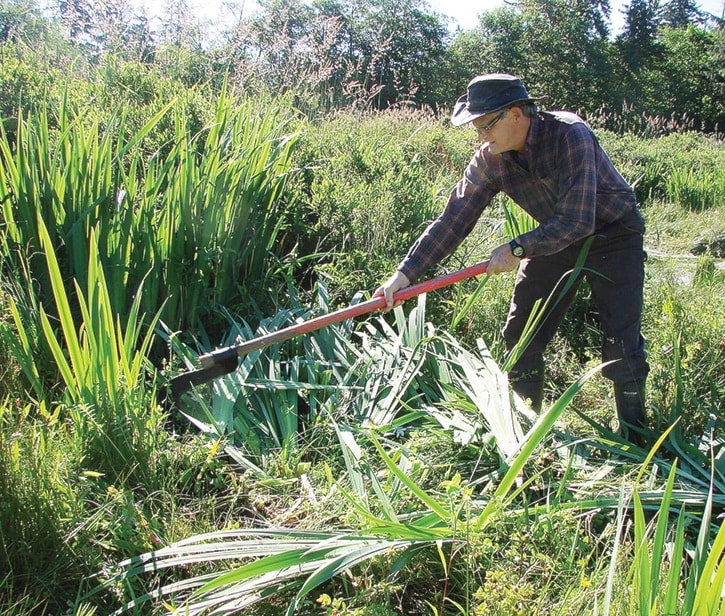Plans are in place for a second attack on yellow flag-iris at the Baikie Island Nature Reserve in early August.
The iris is an invasive plant that is also listed as a noxious weed under the BC Weed Control Act and the city is anxious to address the infestation before it gets any bigger.
Yellow flag iris is an aquatic plant that can grow in both saltwater and freshwater. It spreads by seed and by underground stems.
Introduced to North America a century ago as a showy garden ornamental, the plant has spread widely into natural areas.
Residents are encouraged to refrain from planting it.
“The iris forms very dense clusters and crowds out the natural variety of estuary plants. When biodiversity declines, the whole system becomes less productive and the estuary’s ability to support a wide range of wildlife species is negatively affected,” says Ross Milnthorp, the city’s general manager of parks, recreation and culture.
“In the Campbell River estuary, plants on B.C.’s endangered list are at risk from the spreading iris,” adds Terri Martin, the city’s environmental co-ordinator.
In this year’s iris removal efforts, invasive plant specialists will use a small excavator to dig up the densest infestation areas.
The machine will be walked in on plywood to the far end of the iris patch where the removal will begin.
Ground crews have already cut off as many of the iris seed heads as possible to prevent seed dispersal.
As the iris patches are dug up, soil attached to the plants will be recovered by crews, who will also work to salvage native plants. The iris will be loaded into a trailer and disposed of at the dump.
One month after the iris removal, hand hoeing will remove any new iris sprouts, and the area will be assessed to determine if replanting with native vegetation is required.
This July, a small patch of iris near the Myrt Thompson Trail was hand-dug over two days by a six-person crew from Strategic Group working under the direction of Greenways Land Trust.
“Strategic have continued to be a great supporter of environmental projects in Campbell River, and we were able to collect 1,080 kilograms of iris by hand,” says Cynthia Bendickson, Greenways’ volunteer co-ordinator.
Also in July and for the second year in a row, yellow-flag iris flowers were removed from plants in a portion of the ditch along Petersen Road.
“When the ditch is scheduled for maintenance, we’ll dig up the iris and landfill it. Until that time, our plan is to ensure that no seeds are allowed to spread the infestation downstream,” says Drew Hadfield, the city’s transportation manager.
“Efforts to control the iris are in line with the city’s recently adopted invasive plant species management policy,” says Coun. Larry Samson, who holds Council’s environment portfolio.
“We have a duty to work toward the control of noxious weeds, and we recognize the importance of using best management practices recommended by the Coastal Invasive Species Committee in our work.”
The City has submitted a notification to the Department of Fisheries and Oceans for the project.
